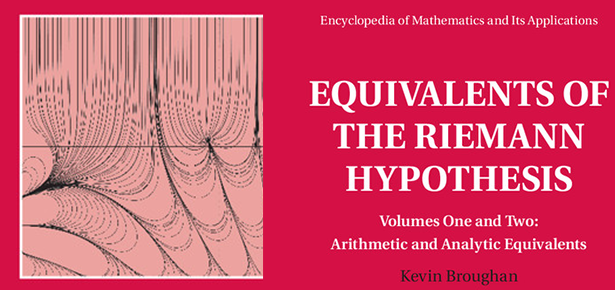
Following moving to partial retirement from my full time position at the University of Waikato, I decided to undertake a range of “extracurricular” activities. These included participating in a Board of Inquiry into a potential inland port on the university doorstep, although I have since decided to move on to greener pastures.
I had been interested in RH for some time, studying the zeta function through flows such as ds/dt=xi(s), which provided an equivalence. However this work, which had a topological basis, ‘’hit the wall” at the point where the structure of the flow near an essential singularity appeared to be important. The underlying theory was not available, and in the circumstances, I was not able to develop it.
A visit to the University of Waikato by Tim Trudgian stimulated work together on aspects of Robin’s inequality and its RH equivalence. In addition to his sterling detailed work on Volume One Chapter 7, his own published work improving Turing’s method for zeta zero analysis was of great value in many chapters.
I approached CUP at some stage near the completion of a draft of volume 1 and they showed interest. However the expert feedback they received was mixed – not only had volume one not covered some of the most valuable equivalences to RH, it did not cover GRH. This was considered to be much more useful than RH for applications, and the idea of two volumes took shape.
Regarding Cambridge, I had been impressed with their expertise and dedication to publishing good mathematics when I worked with them, supplying an appendix and software for Dorian Goldfeld’s book Automorphic Forms and L-functions for the group GL(n,R) (Cambridge, 2006). The new experience writing “Equivalents” showed that this was no exception.
The writing process did not always go smoothly. Some parts, including whole chapters in one case, were scraped. I decided that the details were either too technical or would be too taxing for the reader. My conceptualized target average reader was a graduate student considering potential research problems in pure mathematics and looking for accessible problems. I avoided using results which were at the pre-print stage at the time of writing. This meant sometimes leaving out some published results which depended on unpublished work.
For volume one, the seminal paper of Rosser and Schoenfeld of 1962, and other related papers, provided particular organizational challenges. For volume two, I spent a long time working with Zagier’s group representation equivalence. Eventually I decided to give up. It would be too difficult to give the average reader an adequate background in the specialized theory. In addition Zagier’s method was not able to be extended to number fields.
Given this graduate student target audience, I included quite a lot of background material. For example the chapter on numerical estimates for arithmetic functions, and work of Erdos and others on abundant numbers in volume one. In volume two, an extensive set of appendices provided proofs for the more specialized results referred to in the body of the text, which the reader might not necessarily meet in graduate courses.
I was often asked whether I had (by now) solved RH! Writing a tome of this size does not leave too much energy for such grandiosity, but I did twice believe I might have disproved RH. This was while writing volume two, once when considering integral equations, namely the method of Sekatskii, Beltraminelli ad Merlini in Volume Two Section 8.3, and once when developing examples for Weil’s explicit formula in Volume Two Section 9.5. In both cases the approach came to nothing.
After the volumes were published I created a website for Errata and notes, GRHpack and RHpack. I have had an excellent volume of feedback giving corrections and other comments which have been included or will be once time permits – this is especially welcome. Some folk even indicated they had been right through both volumes!
As expected, equivalents to RH and GRH continue to evolve. In late 2017, the University of Waikato had a visit from Ken Ono who gave a fascinating lecture related to the Jensen polynomial equivalence of Polya from 1927, namely that RH is equivalent to all of the Jensen polynomials of the Xi function being hyperbolic. He described a discovery Don Zagier, Michael Griffin, Larry Rolen and himself which, among other advances, shows that for each degree all but a finite number of the Jensen polynomials are hyperbolic. This work is being written up and will be referenced in the “Errata and notes” relating to Volume Two Section 4.4. when a pre-print appears on ArXiv.
And In February 2018 Brad Rogers and Terence Tao published on ArXiv an article entitled “The de Bruijn-Newman constant is non-negative”, giving the RH equivalence Lambda=0. A full report on this work would make a nice addition to Volume Two Chapter 5. Both of the works of Rogers/Tao and Griffen/Ono/Rolen/Zagier will be included in a second edition, should one be published.
Find out more about Kevin Broughan’s 2-volume work Equivalents of the Riemann Hypothesis here.
Latest Comments
Have your say!